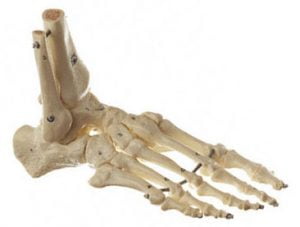
Is it a stress fracture?
Many people are returning to walking or running for exercise or playing outdoor sports after being cooped up. It’s the time of year Podiatrists tend to see an increase in overuse injuries, which occur from repetitive stress on a muscle, bone or joint over time. People often develop this type of injury after ramping up a sport or athletic activity too quickly.
One of the most common overuse injuries is a stress fracture, and the foot is particularly vulnerable.
Repeated impact on a bone that is starting to weaken from overdoing it can eventually lead to a small break or crack. A stress fracture does not cause the bone to shift position. When people think of bones, they think they’re hard like metal, but the bones in the foot are more like tree branches. They can bend a little bit, and if you bend them enough times, they can crack. The foot is one of the most common locations to sustain a stress fracture because we are constantly on our feet.
The foot is an anatomical marvel, with 26 small bones, 33 joints and a network of more than 100 muscles, tendons and ligaments that work together to support our body weight, provide stability, and allow movement. Our feet are designed to absorb a tremendous amount of force with every step we take.
Stress fractures are often seen in runners, in athletic people who participate in high-impact repetitive sports and in older people who have weakened bones. Individuals who don’t rest adequately in between workouts or keep playing a sport despite exhaustion are at increased risk, as are people who take steroids.
The challenge is that when you’ve been inactive for so long, the body gets weaker and cannot handle an activity at the previous intensity. The key is to gradually build up your activity to make sure your body can handle the load. If you’ve never run before and want to start running, for example, start with walking first, then jogging and then gradually start running.
The main symptom of a stress fracture is pain, which generally occurs in the spot where the bone is broken. People may also experience swelling and bruising. Anyone who may have suffered a stress fracture is advised to immediately stop any activity that is causing the discomfort. The main treatment for a stress fracture is rest.
For pain that comes on suddenly, people can try using ice and elevating their foot to see if the pain improves. If it doesn’t get better after a few hours or people start experiencing pain on days they’re not working out, the experts recommend seeing a Resonance Step + Stride Podiatrist.
A stress fracture is diagnosed based on recent activities, any possible injury and where the pain is felt. A Podiatrist will examine the foot and order X-rays, and if needed, refer for a CT scan or MRI to make the diagnosis.
Surgery is rarely needed for a stress fracture. As a general rule, many fractures of the foot can be treated without surgery by wearing protective shoe wear: either an orthopaedic boot or a hard-soled shoe. People can generally put weight their foot when wearing the protective footwear. Most stress fractures heal in four to six weeks.
Lifestyle choices and good habits can lower the risk of developing a stress fracture, not only in the foot, but in other bones as well. People should support their bone health with adequate consumption of calcium and vitamin D.
The importance of wearing supportive shoes is foremost. Flimsy footwear such as flip flops or ballet slippers do not provide adequate support. We take more than a million steps a year. So, if you take 5,000 to 10,000 steps a day in shoes that aren’t giving you a lot of support, it’s that much extra stress on your feet with every step you take.
Call us today to resolve your foot pain.
0800 473 776
(09) 212 9612
#stepandstridepodiatry #respod
